
by Helga Moser | Nov, 2025 | Bonn Sights, culinary, EN, points of interest, Rhine region, tradition
When the days get darker in the dreary month of November and the wet cold dampens the mood, I go to the Christmas market before the winter blues gets a hold of me. Around the Münsterplatz in Bonn, wooden stalls are set up and create a cosy atmosphere with Christmas decorations and bright lights. The enticing aromas of mulled wine, cinnamon, roasted almonds and delicious food inevitably lift the spirits.
At the foot of the Bonn Minster, the city is teeming with life, but at the same time it feels homely . I feel transported back in time and imagine how our Bonn ancestors came to this square in the late Middle Ages to stock up on supplies for the coming winter, to enjoy good food and drink and, of course, to exchange the latest gossip.
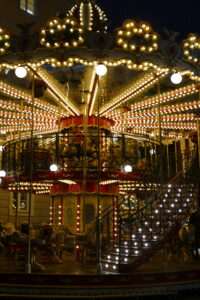
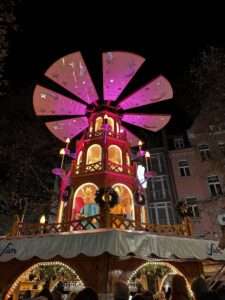 Today, more than half a millennium later, it is not much different. In a large part of the 160 wooden stalls placed between Remigiusplatz, Münsterplatz and Friedensplatz, you can buy beautiful and useful items, including hand-made crafts, which make for great Christmas presents for family and friends. Here you will find unique items that are not available in the usual department stores. Inspired by the lovingly decorated displays, you’ll discover gifts that you would never have thought of while lounging on your sofa at home. For example, original jewellery pendants or maybe hand-knitted socks made of pure wool for your daughter, who always has cold feet? And for your girlfriend, who already has everything, a new Christmas ornament is always a hit! And of course, every once in a while I need a little refreshment. The Flammlachs (salmon cooked on an open fire) smells seductive, but I usually return to the Rhine-region classic, Reibekuchen, potatoe pancakes with apple compote. In addition, the sounds of Christmas can be heard from everywhere. The happy laughter of children coming from the direction of the historic carousel reminds me of the dear little ones in my family. For them, I have to make a choice between a handcrafted wooden toy and a cute Perlgraupentier (a figurine of a German miner). Slowly, the shopping bag I brought with me is proving not big enough. But I don’t need to worry because one of the traditional stalls has a selection of beautiful baskets: I have been eyeing them for a long time. No sooner said than done – now I just have to get the hand-made wrapping paper and my Christmas market tour will be a roaring success.
Today, more than half a millennium later, it is not much different. In a large part of the 160 wooden stalls placed between Remigiusplatz, Münsterplatz and Friedensplatz, you can buy beautiful and useful items, including hand-made crafts, which make for great Christmas presents for family and friends. Here you will find unique items that are not available in the usual department stores. Inspired by the lovingly decorated displays, you’ll discover gifts that you would never have thought of while lounging on your sofa at home. For example, original jewellery pendants or maybe hand-knitted socks made of pure wool for your daughter, who always has cold feet? And for your girlfriend, who already has everything, a new Christmas ornament is always a hit! And of course, every once in a while I need a little refreshment. The Flammlachs (salmon cooked on an open fire) smells seductive, but I usually return to the Rhine-region classic, Reibekuchen, potatoe pancakes with apple compote. In addition, the sounds of Christmas can be heard from everywhere. The happy laughter of children coming from the direction of the historic carousel reminds me of the dear little ones in my family. For them, I have to make a choice between a handcrafted wooden toy and a cute Perlgraupentier (a figurine of a German miner). Slowly, the shopping bag I brought with me is proving not big enough. But I don’t need to worry because one of the traditional stalls has a selection of beautiful baskets: I have been eyeing them for a long time. No sooner said than done – now I just have to get the hand-made wrapping paper and my Christmas market tour will be a roaring success.
A toast is in order! Relaxing as Christmas approaches, I treat myself to an eggnog, a drink made from white wine, egg liqueur, vanilla and sugar, served hot and garnished with whipped cream. It actually sounds rather fearsome, but it is surprisingly delicious and hits the spot. The fact that I’m standing here alone doesn’t bother me at all. Because we are in the Rhineland it takes no time at all before I am chatting with a fellow eggnog-drinker about the Christmas season.
Of course, this will not be my only visit to a Christmas market. Like so many, I will meet up with friends for a mulled wine on numerous occasions throughout the season. It sweetens up the dreary weather – and when it’s bitter cold outside, the drinks taste even better!
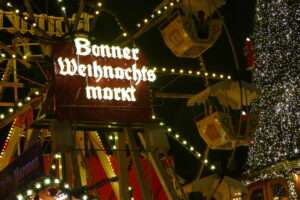 And soon, I’ll be going to the Bonn Greeters’ Christmas market meet-up, which takes place every year. We’ll be swapping anecdotes and information, taking a stroll through the rows of stalls and sampling the wares at various stands. Of course, it’s all preparation for when we show guests around the market, as Christmas markets are one of the top points of interest.
And soon, I’ll be going to the Bonn Greeters’ Christmas market meet-up, which takes place every year. We’ll be swapping anecdotes and information, taking a stroll through the rows of stalls and sampling the wares at various stands. Of course, it’s all preparation for when we show guests around the market, as Christmas markets are one of the top points of interest.
The Christmas market is open until 23 December, with stalls open from 11 a.m. to 9 p.m., and food and drink stalls open until 9:30 p.m. on Sundays to Thursdays, and until 10:30 p.m. on Fridays and Saturdays. And for those who don’t want to leave the cosy setting so quickly, Bonn Tourism there is a Holy Three Kings’ market, which will extend beyond the pre-Christmas period. It will take place on Remigiusplatz from 27 December up to and including 6 January.

by Gert Fischer | Oct, 2025 | Bonn Sights, famous people from Bonn, history, points of interest
In 2025, the Fördergesellschaft für den Alten Friedhof Bonn e.V. (Friends of Bonn’s Old Cemetery Association) celebrates its 50th anniversary. The Bonn Greeters would like to offer their heartfelt congratulations! Through its work, the association makes an important contribution to the preservation and maintenance of one of Bonn’s most significant historical landmarks.
 The so-called ‘Old Cemetery’ is easy to overlook. It is surrounded by walls and squeezed between three main roads and the railway line. Its entrance is at the beginning of Bornheimer Straße, almost directly next to the town hall. When you walk through the gate you enter another world. Graves from times long past lie in the shade of tall trees. Weathered gravestones and rusted wrought-iron crosses dominate the scene. Some are crooked. Many of the graves are obviously no longer maintained and are overgrown. The traffic noise fades into the background and birdsong dominates. It is no wonder that feature films are occasionally shot here. Fog machines are turned on and eerie figures stride through the night. The rattling of the railway is suppressed.
The so-called ‘Old Cemetery’ is easy to overlook. It is surrounded by walls and squeezed between three main roads and the railway line. Its entrance is at the beginning of Bornheimer Straße, almost directly next to the town hall. When you walk through the gate you enter another world. Graves from times long past lie in the shade of tall trees. Weathered gravestones and rusted wrought-iron crosses dominate the scene. Some are crooked. Many of the graves are obviously no longer maintained and are overgrown. The traffic noise fades into the background and birdsong dominates. It is no wonder that feature films are occasionally shot here. Fog machines are turned on and eerie figures stride through the night. The rattling of the railway is suppressed.
The cemetery has been in existence since 1715. At that time, it was located just outside the city fortifications. It owes its triangular layout to the fork in the road where Archbishop Elector Joseph Clemens – better known as the creator of the residential palace, now the university – had it laid out. It was originally intended for soldiers, strangers and poor people, i.e. those whose families did not have graves in the inner-city cemeteries. In 1787, it became the city’s only cemetery: Elector Max Franz closed the parish cemeteries and turned it into a ‘general burial ground’. The reason for this was the realisation that the overcrowded churchyards posed a health risk to the city’s population. In this respect, Bonn was ahead of its time. In most other cities in the Rhineland, such measures were only ordered during French rule after 1794.
The Old Cemetery retained its function as ‘the’ Bonn cemetery until its closure in 1884. From then on, burials were only permitted if the family already had a grave on the site, as there was no more room for expansion. The cemetery was surrounded by buildings on all sides.
An information board at the entrance, as well as the Fördergesellschaft’s website, offer maps and a detailed overview of the VIP tombstones . There is much more to discover than the graves of Beethoven’s mother, Clara and Robert Schumann, Barthold Georg Niebuhr or Ernst Moritz Arndt, because the Old Cemetery reflects the history of bourgeois Bonn in the 19th century. In addition to the graves of well-known and lesser-known Bonn families, the resting places of university professors also play an important role. This part of the cemetery register reads like a “Who’s Who” of the German scholarly world of that time. Scattered across the grounds, we also find traces of the British colony, which was important for the social history of the city. Somewhat hidden away are the graves of French soldiers from the war of 1870/71. Added to this is the art-historical dimension. A tour of the cemetery is always a journey through the representative funeral culture of the 19th century. Particularly important are the cemetery chapel – built in the 13th century as the chapel of the Teutonic Order in Ramersdorf and moved here in the 1840s as an early example of monument preservation – and the former market cross of the medieval market in Dietkirchen in the north of Bonn.
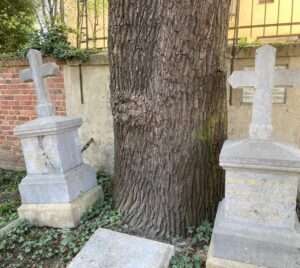 Another treasure of the Old Cemetery is its trees, some of which date back to the 19th century. This is where problems become apparent: in some places, monument preservation and nature conservation compete with each other, as the tree roots threaten historic graves. Nowhere is this more evident than at the grave of Ernst Moritz Arndt, where the oak tree he planted himself almost 200 years ago is in the process of overturning the gravestones.
Another treasure of the Old Cemetery is its trees, some of which date back to the 19th century. This is where problems become apparent: in some places, monument preservation and nature conservation compete with each other, as the tree roots threaten historic graves. Nowhere is this more evident than at the grave of Ernst Moritz Arndt, where the oak tree he planted himself almost 200 years ago is in the process of overturning the gravestones.
Another problem is that the majority of the graves are no longer in use. The families have died out or now bury their members elsewhere. This means that time has practically stood still. This is a major challenge for the city, because although it can preserve the site as a whole, it does not have the resources to maintain the countless unused graves, let alone preserve the gravestones, apart from the graves of honour. On the other hand, ‘clearing’ the graves after the burial periods have expired, as is customary in normal cemeteries, is not an option due to the historical significance of the site and the existing monument protection. The support association helps to solve this dilemma. Among other things, it is responsible for the restoration of graves of historical or art-historical significance.
Another option is the ‘grave sponsorships’ arranged by the support association. In this case, the sponsors take over the maintenance of an abandoned grave, including the restoration of the gravestone, and thus acquire the right from the city of Bonn to be buried in this grave sometime in the future. Not everyone may like the idea of lying under someone else’s gravestone and being limited to a modest stone cushion with their own name on it. And some people also consider it morbid for someone to maintain their own grave during their lifetime. However, my wife and I find it somehow reassuring to know where we will end up – if nothing else comes in between.
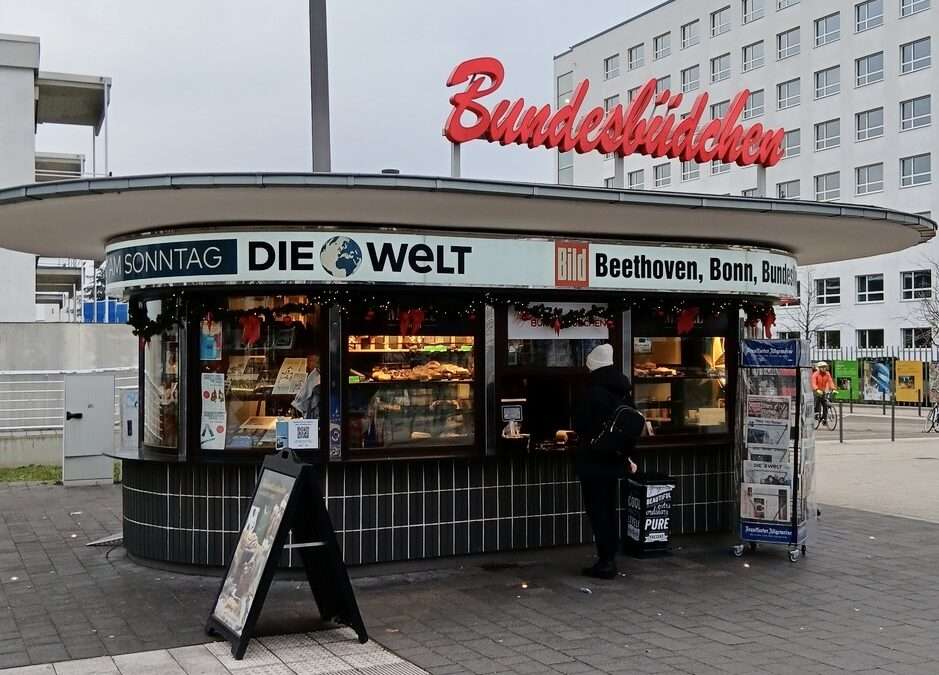
by Annette Bohlen | Sep, 2025 | architecture, EN, history, points of interest
Built in 1957 and kidney-shaped, with a tiled base and a wide canopy: a (cult) kiosk in the middle of the UN and former government district in Bonn.
In this district, somewhat away from the city centre, there has never been many shops or restaurants, just a small row of kiosks for essentials during government times. But the most important newspapers were available at Jürgen Rasche’s kiosk, named after his mother, the long-time owner. This is where prominent politicians of the time, such as Joschka Fischer and Norbert Blüm, as well as employees of the surrounding federal institutions and journalists would meet for a coffee or a bratwurst. In this government district, the distances to offices and meetings or to the plenary hall were short on foot or by bicycle, and people liked to meet for personal exchanges in the absence of other options in the press club, in Villa Dahm or in the small bar under the substitute plenary hall on the banks of the Rhine. Or – as mentioned – for a quick exchange of information at the Büdchen.
-

With the relocation of the capital to Berlin in 1999, the Bundesbüdchen initially lost its importance and eventually had to make way for the new WCCB (World Conference Centre Bonn) building. At least the noble kiosk was saved by its listed status and stored in a freight yard. It remained a symbol for the people of Bonn of the city’s heyday as the seat of government, so a dedicated support association was eventually able to finance its restoration, and today we can enjoy this relic from the days of government, now located next to the World Conference Centre, where bread rolls, cakes and more are sold.
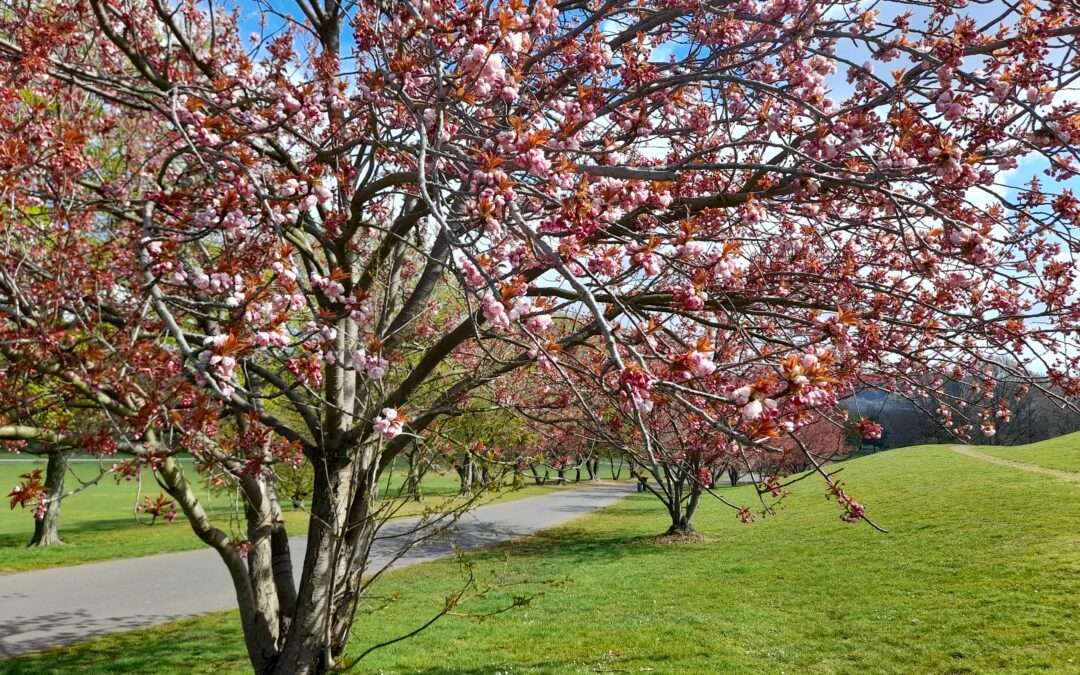
by Helga Stark | Apr, 2025 | Bonn Sights, EN, points of interest, tradition
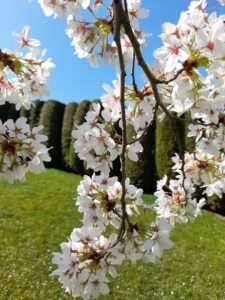 In the first phase the white-flowered cherries, such as the plum cherry in Wolfstraße, Franzstraße or in the Rheinaue, bloom. After that it takes about 14 days for the thick pink-flowered Japanese flowering cherries (especially in Breite Straße and Heerstraße) to delight the eye.
In the first phase the white-flowered cherries, such as the plum cherry in Wolfstraße, Franzstraße or in the Rheinaue, bloom. After that it takes about 14 days for the thick pink-flowered Japanese flowering cherries (especially in Breite Straße and Heerstraße) to delight the eye.
How did Bonn get these magnificent cherries in the first place? In the 1980s, the Old Town (which is actually the Nordstadt and was only renamed ‘Old Town’ for tourist reasons) was redeveloped. Traffic was forced to slow down and Japanese cherries were planned to provide a splash of colour. The cherry trees were a gift from the Japanese government to Bonn and the city planner Brigitte Denkel made sure that they were planted. The cherry blossoms symbolise the friendship between Japan and Germany.
In many cultures, cherry blossoms have a special symbolic meaning, especially in Japan, where they are a symbol of beauty, transience and new beginnings.
On weekends there is also a flea market, design market and food market, which attract tens of thousands of people on the streets. All the shops, cafés and pubs in the area are prepared for the crowds. Those who prefer it quieter come during the week, in the morning or evening. Night photos of the cherry blossoms are also worth the visit after hours.
If you don’t want to plunge into the hustle and bustle, you can find Japanese cherry trees in Beuel, for example, on Professor-Neu-Allee or in the Rheinaue park.
My personal favourite cherry blossom spot is a small avenue in the Rheinaue near the Japanese garden: these cherry trees were donated by a Japanese choir that performs Beethoven’s ‘Ode to Joy’ every year with about 5,000 singers. The cherry trees were a gift in honour of Beethoven’s birthplace. Beethoven is as revered in Japan as the cherry blossom, but that’s another story…
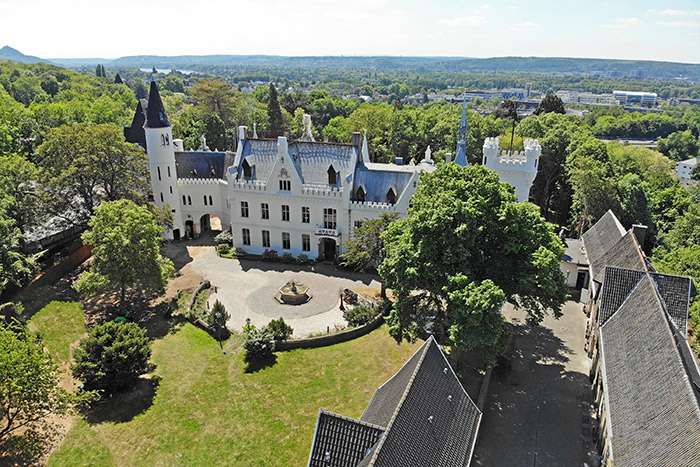
by Marisa De Luca | Mar, 2025 | architecture, EN, points of interest, Rhine region
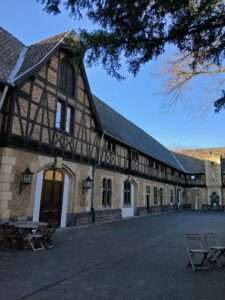 From the terrace of the castle, you can see as far as Cologne Cathedral and, of course, the whole of Bonn. The view, under a bright blue sky, is truly magical. Fortunately in the 1970s a citizens’ initiative was able to save the castle from demolition with a view to construct a motorway junction.
From the terrace of the castle, you can see as far as Cologne Cathedral and, of course, the whole of Bonn. The view, under a bright blue sky, is truly magical. Fortunately in the 1970s a citizens’ initiative was able to save the castle from demolition with a view to construct a motorway junction.
The castle has had a chequered history since it was built as the headquarters of the Teutonic Order in the 13th century in connection with the Crusades. Until secularisation in 1803, it was the economic base of the Teutonic Order and then the seat of several noble families. The remarkable architecture that can be seen today was created in a predominantly neo-Gothic style after a major fire broke out during reconstruction in 1842.
Among the numerous owners, the first youthful resident, Baroness von Francq (stepdaughter of the then owner, Prince Joseph zu Salm-Reifferscheidt-Dyck), deserves special mention. She lived in the castle from 1861 to 1881 and left her mark on the castle, which had since been spruced up with the addition of an English-style extension – at that time the rooms for the ladies – and the expansion of the extensive Ennert Park, including the planting of exotic trees. She also had some of the furnishings installed, which were unusually modern for the time, such as a powder room on the upper floor.
Another owner, Albert Moritz Freiherr von Oppenheim, also left his mark. As a banker and art collector, he was responsible for the interior design of the castle, which is particularly evident in the stairwell and in today’s restaurant. This heritage – wall panelling and historicist-style ceiling mouldings – was gradually restored by the new owners after the building was used by various institutions after the Second World War. The result is an extraordinary hotel and restaurant, and further rooms on the upper floor are being restored while business continues. Today, people are proud of the fact that Tina Turner liked to stay in a suite in the white tower, away from the hustle and bustle of Cologne, and that other celebrities, sheikhs with their families or guests from the worlds of business and politics now also stay here.
Since 2017, a Cologne restaurateur and an investment company have been running the extraordinary restaurant, hotel and the coach house for events. It is even possible to have a civil wedding here at the Schlosshotel Kommende. It’s definitely worth a visit!
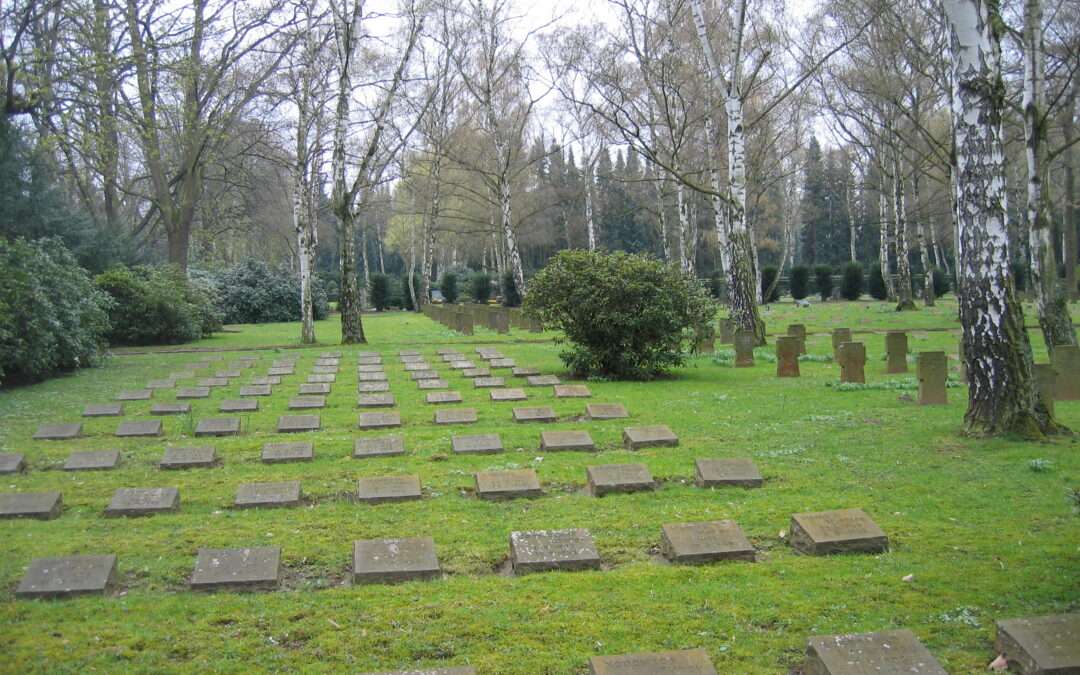
by Gert Fischer | Mar, 2025 | EN, points of interest, tradition
With the Old Cemetery in the city centre, the Bad Godesberg Castle Cemetery and the Poppelsdorf Cemetery, Bonn has three outstanding burial sites due to their significance, ambience or location. If you add to this the village churchyards in some districts that are still preserved and date back even further, Bonn’s cemetery landscape is almost worth a trip. This historical heritage overshadows the more modern facilities.
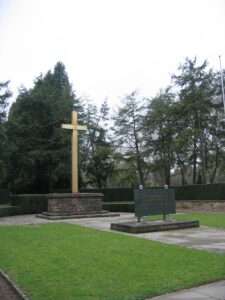
Photo: A. Savin
Thus, Bonn’s largest cemetery by far, the Nordfriedhof on Kölnstraße in today’s Auerberg district, is perhaps the Cinderella of cemeteries. Opened in 1884 as the official successor to the Old Cemetery, which could no longer be expanded, the Nordfriedhof got off to a bad start mainly due to its location. More than three kilometres from the centre of Bonn, it was on the far northern outskirts of the city. It only received a rail connection in 1906, when the Rheinuferbahn (Rhine bank railway) started operating. In the first decades of its existence, it was located in an open field. On the way there, you passed the smouldering rubbish heap where today’s Sportpark Nord is located, the Rheinische Provinzial-Irrenanstalt (today the LVR-Klinik Bonn), the Städtische Hilfshospital für Geisteskranke, Epileptiker und Trunksüchtige (a municipal hospital for the mentally ill, epileptics and alcoholics) and the orphanage and correctional home, which was located on the former site of the leprosarium (an isolation ward for infectious diseases). And contemporaries were certainly also aware that the cemetery area included the former place of execution with the gallows and the Schindanger, where animal carcasses that could no longer be used were disposed of. It is therefore not surprising that the so-called ‘better circles’ at the time sought burial sites elsewhere. After 1905, this was also officially possible. Those who lived ‘west of the railway’ could be buried in the cemetery of the recently incorporated Poppelsdorf. The inhabitants of the southern and western parts of the city made ample use of this opportunity. The Nordfriedhof thus became the cemetery for the city centre and the northern part of the city. Accordingly, the names of the families buried here that are significant in local history are linked to this part of the city. The graves of professors and wealthy individuals were buried mainly in the Poppelsdorf Cemetery, as were those of many of Bonn’s dignitaries.
Nevertheless, the North Cemetery gradually gained its place in the Bonn cemetery landscape. It changed for the better as a park, designed in an exemplary manner including a large chapel added in 1913. Its subsequent three expansions prove that it has become a popular cemetery. Even the reckless handling of some of its remnants could not prevent this. In the 1960s, for example, rows of gravestones were cleared when the main entrance was widened, and the neo-Romanesque gate was demolished. As a result, the list of ‘preserving-worthy’ grave monuments is short compared to the size of the cemetery.
The character of the Nordfriedhof as a cemetery of honour represents a special chapter. The beginnings of this development lie in the First World War. Today, not only the German victims of two world wars are buried here, but also numerous forced and foreign labourers as well as prisoners of war. Initially a place of local remembrance, the war cemetery and cemetery of honour became the central ‘Memorial of the Federal Republic of Germany for the Victims of War and the Victims of Tyranny’ in 1980 (today in Berlin at the Neue Wache). At that time, the bronze plate designed by Hans Schwippert – known as the architect who converted the Pedagogical Academy into the Bundeshaus and Palais Schaumburg into the Federal Chancellery – was transferred from the Hofgarten to the Nordfriedhof for this purpose. One of the more embarrassing chapters in Bonn’s history is that in 2017 it was stolen and replaced by a copy in sandstone.
As a relatively modern cemetery, the Nordfriedhof was not consecrated by a Catholic priest and was not bound to historical structures. Therefore, it reflects the developments that have shaped the funeral industry in the recent past better than many older cemeteries and those that are subject to preservation orders that restrict them to an earlier state. For example, a Yazidi cemetery is integrated into the Nordfriedhof. There are graves where the Greek Orthodox or Russian Orthodox rites were observed, as well as an area for children who died in the womb or at birth. And since 1990, it has had an Islamic burial ground.
A walk through the Nordfriedhof Cemetery is therefore not so interesting if you are interested in art, historically significant graves and famous names. Rather, it is a generously laid out park that reflects the social structure of Bonn city centre and the north of Bonn. Nevertheless, exciting discoveries are not out of the question. For example, there are three graves of members of the Sikh religious community who came to Bonn with the British occupation troops after the First World War. Or the grave of the singer and entertainer Fereydun Farrochsad, who was murdered in Bonn in 1992 in the name of the Islamic revolution in Iran.
Furthermore, the Nordfriedhof is of ecological interest. It has remarkable trees and, due to its size, a wide variety of animal and plant life. With the support of the Rotary Club, the city of Bonn is using it as an experimental area for ‘future trees’ – as a ‘climate grove’.
It is to be hoped that the restoration work on the cemetery chapel, which has been going on for two years now, will finally be completed. Until then, funeral services are held in an unworthy plastic tent. The North Cemetery is still worth a visit!


 Today, more than half a millennium later, it is not much different. In a large part of the 160 wooden stalls placed between Remigiusplatz, Münsterplatz and Friedensplatz, you can buy beautiful and useful items, including hand-made crafts, which make for great Christmas presents for family and friends. Here you will find unique items that are not available in the usual department stores. Inspired by the lovingly decorated displays, you’ll discover gifts that you would never have thought of while lounging on your sofa at home. For example, original jewellery pendants or maybe hand-knitted socks made of pure wool for your daughter, who always has cold feet? And for your girlfriend, who already has everything, a new Christmas ornament is always a hit! And of course, every once in a while I need a little refreshment. The Flammlachs (salmon cooked on an open fire) smells seductive, but I usually return to the Rhine-region classic, Reibekuchen, potatoe pancakes with apple compote. In addition, the sounds of Christmas can be heard from everywhere. The happy laughter of children coming from the direction of the historic carousel reminds me of the dear little ones in my family. For them, I have to make a choice between a handcrafted wooden toy and a cute Perlgraupentier (a figurine of a German miner). Slowly, the shopping bag I brought with me is proving not big enough. But I don’t need to worry because one of the traditional stalls has a selection of beautiful baskets: I have been eyeing them for a long time. No sooner said than done – now I just have to get the hand-made wrapping paper and my Christmas market tour will be a roaring success.
Today, more than half a millennium later, it is not much different. In a large part of the 160 wooden stalls placed between Remigiusplatz, Münsterplatz and Friedensplatz, you can buy beautiful and useful items, including hand-made crafts, which make for great Christmas presents for family and friends. Here you will find unique items that are not available in the usual department stores. Inspired by the lovingly decorated displays, you’ll discover gifts that you would never have thought of while lounging on your sofa at home. For example, original jewellery pendants or maybe hand-knitted socks made of pure wool for your daughter, who always has cold feet? And for your girlfriend, who already has everything, a new Christmas ornament is always a hit! And of course, every once in a while I need a little refreshment. The Flammlachs (salmon cooked on an open fire) smells seductive, but I usually return to the Rhine-region classic, Reibekuchen, potatoe pancakes with apple compote. In addition, the sounds of Christmas can be heard from everywhere. The happy laughter of children coming from the direction of the historic carousel reminds me of the dear little ones in my family. For them, I have to make a choice between a handcrafted wooden toy and a cute Perlgraupentier (a figurine of a German miner). Slowly, the shopping bag I brought with me is proving not big enough. But I don’t need to worry because one of the traditional stalls has a selection of beautiful baskets: I have been eyeing them for a long time. No sooner said than done – now I just have to get the hand-made wrapping paper and my Christmas market tour will be a roaring success. And soon, I’ll be going to the Bonn Greeters’ Christmas market meet-up, which takes place every year. We’ll be swapping anecdotes and information, taking a stroll through the rows of stalls and sampling the wares at various stands. Of course, it’s all preparation for when we show guests around the market, as Christmas markets are one of the top points of interest.
And soon, I’ll be going to the Bonn Greeters’ Christmas market meet-up, which takes place every year. We’ll be swapping anecdotes and information, taking a stroll through the rows of stalls and sampling the wares at various stands. Of course, it’s all preparation for when we show guests around the market, as Christmas markets are one of the top points of interest.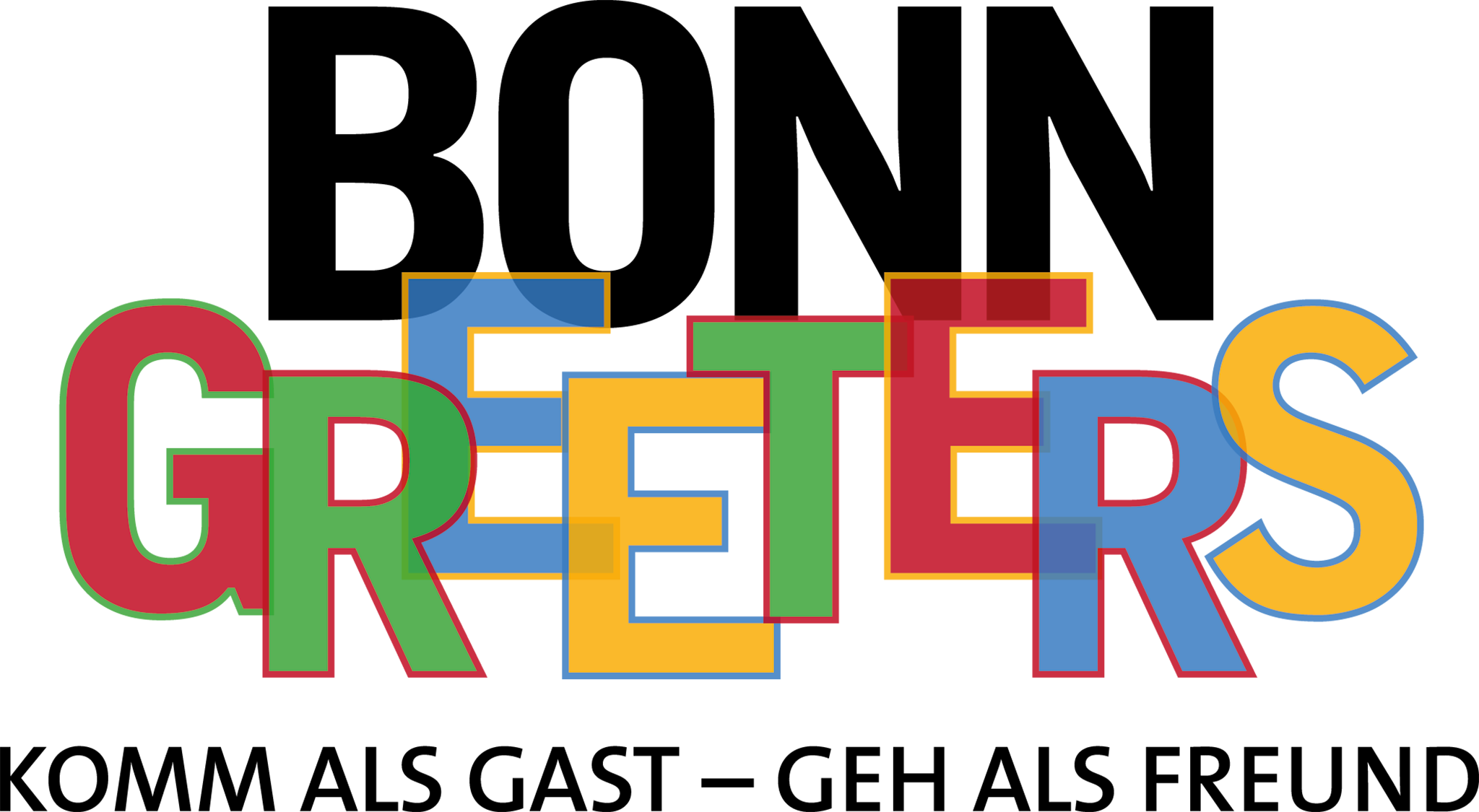

 The so-called ‘Old Cemetery’ is easy to overlook. It is surrounded by walls and squeezed between three main roads and the railway line. Its entrance is at the beginning of Bornheimer Straße, almost directly next to the town hall. When you walk through the gate you enter another world. Graves from times long past lie in the shade of tall trees. Weathered gravestones and rusted wrought-iron crosses dominate the scene. Some are crooked. Many of the graves are obviously no longer maintained and are overgrown. The traffic noise fades into the background and birdsong dominates. It is no wonder that feature films are occasionally shot here. Fog machines are turned on and eerie figures stride through the night. The rattling of the railway is suppressed.
The so-called ‘Old Cemetery’ is easy to overlook. It is surrounded by walls and squeezed between three main roads and the railway line. Its entrance is at the beginning of Bornheimer Straße, almost directly next to the town hall. When you walk through the gate you enter another world. Graves from times long past lie in the shade of tall trees. Weathered gravestones and rusted wrought-iron crosses dominate the scene. Some are crooked. Many of the graves are obviously no longer maintained and are overgrown. The traffic noise fades into the background and birdsong dominates. It is no wonder that feature films are occasionally shot here. Fog machines are turned on and eerie figures stride through the night. The rattling of the railway is suppressed.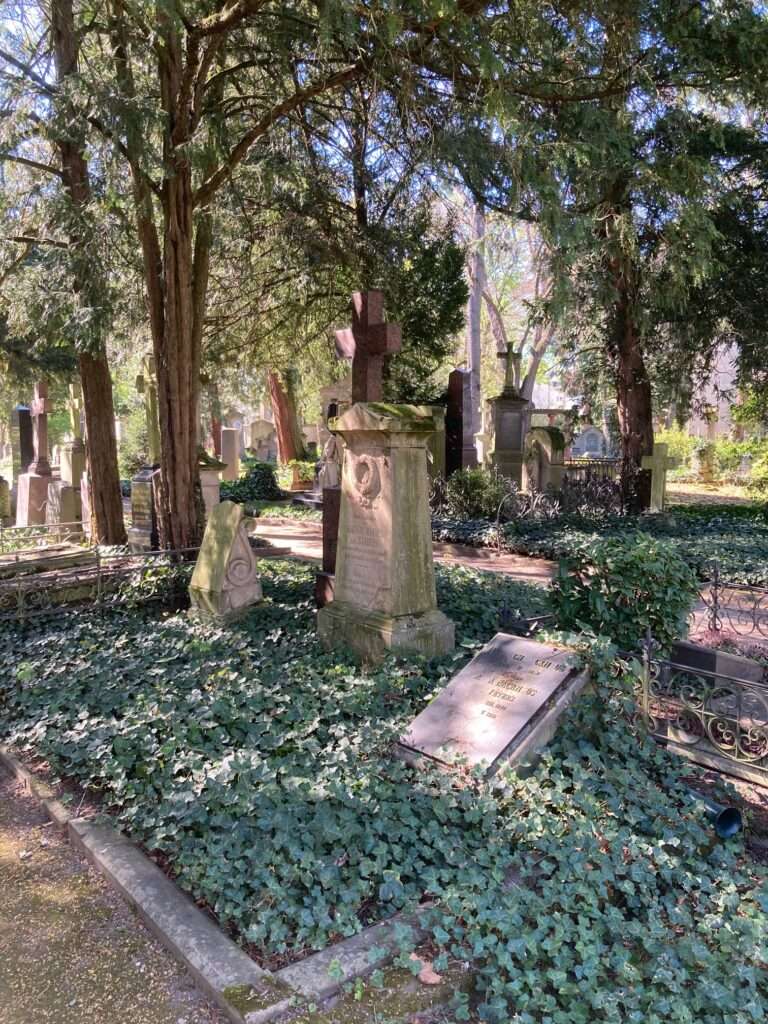
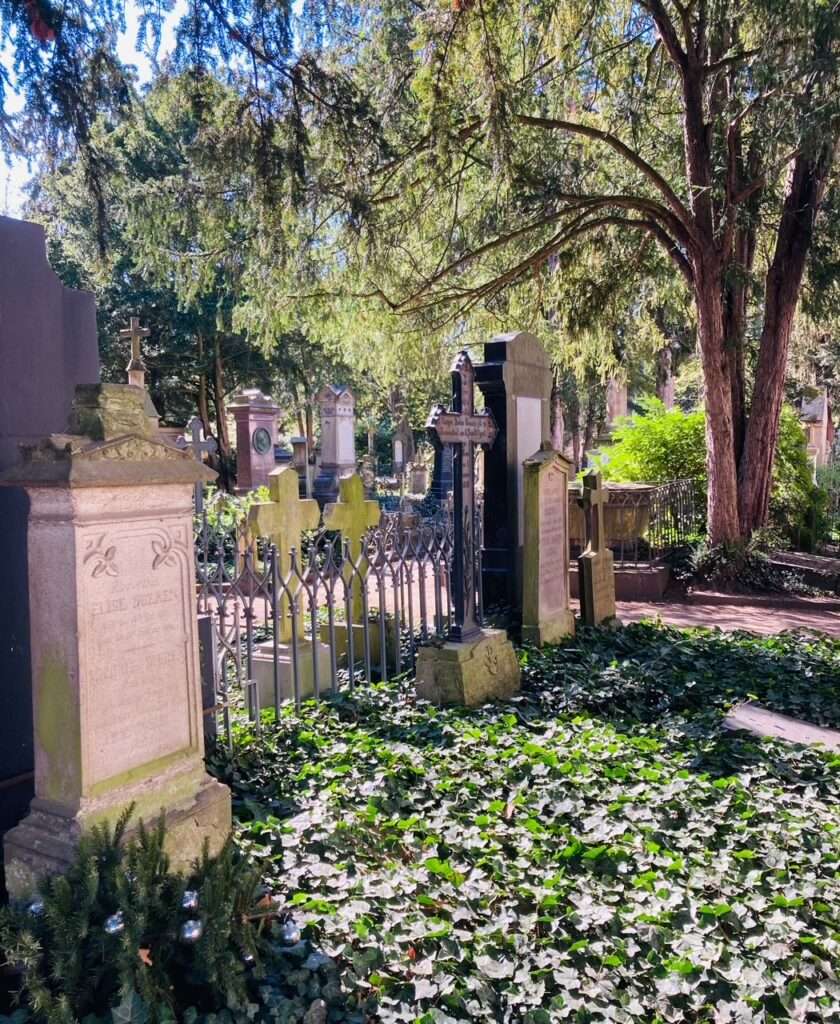

 Another treasure of the Old Cemetery is its trees, some of which date back to the 19th century. This is where problems become apparent: in some places, monument preservation and nature conservation compete with each other, as the tree roots threaten historic graves. Nowhere is this more evident than at the grave of Ernst Moritz Arndt, where the oak tree he planted himself almost 200 years ago is in the process of overturning the gravestones.
Another treasure of the Old Cemetery is its trees, some of which date back to the 19th century. This is where problems become apparent: in some places, monument preservation and nature conservation compete with each other, as the tree roots threaten historic graves. Nowhere is this more evident than at the grave of Ernst Moritz Arndt, where the oak tree he planted himself almost 200 years ago is in the process of overturning the gravestones.


 In the first phase the white-flowered cherries, such as the plum cherry in Wolfstraße, Franzstraße or in the Rheinaue, bloom. After that it takes about 14 days for the thick pink-flowered Japanese flowering cherries (especially in Breite Straße and Heerstraße) to delight the eye.
In the first phase the white-flowered cherries, such as the plum cherry in Wolfstraße, Franzstraße or in the Rheinaue, bloom. After that it takes about 14 days for the thick pink-flowered Japanese flowering cherries (especially in Breite Straße and Heerstraße) to delight the eye.

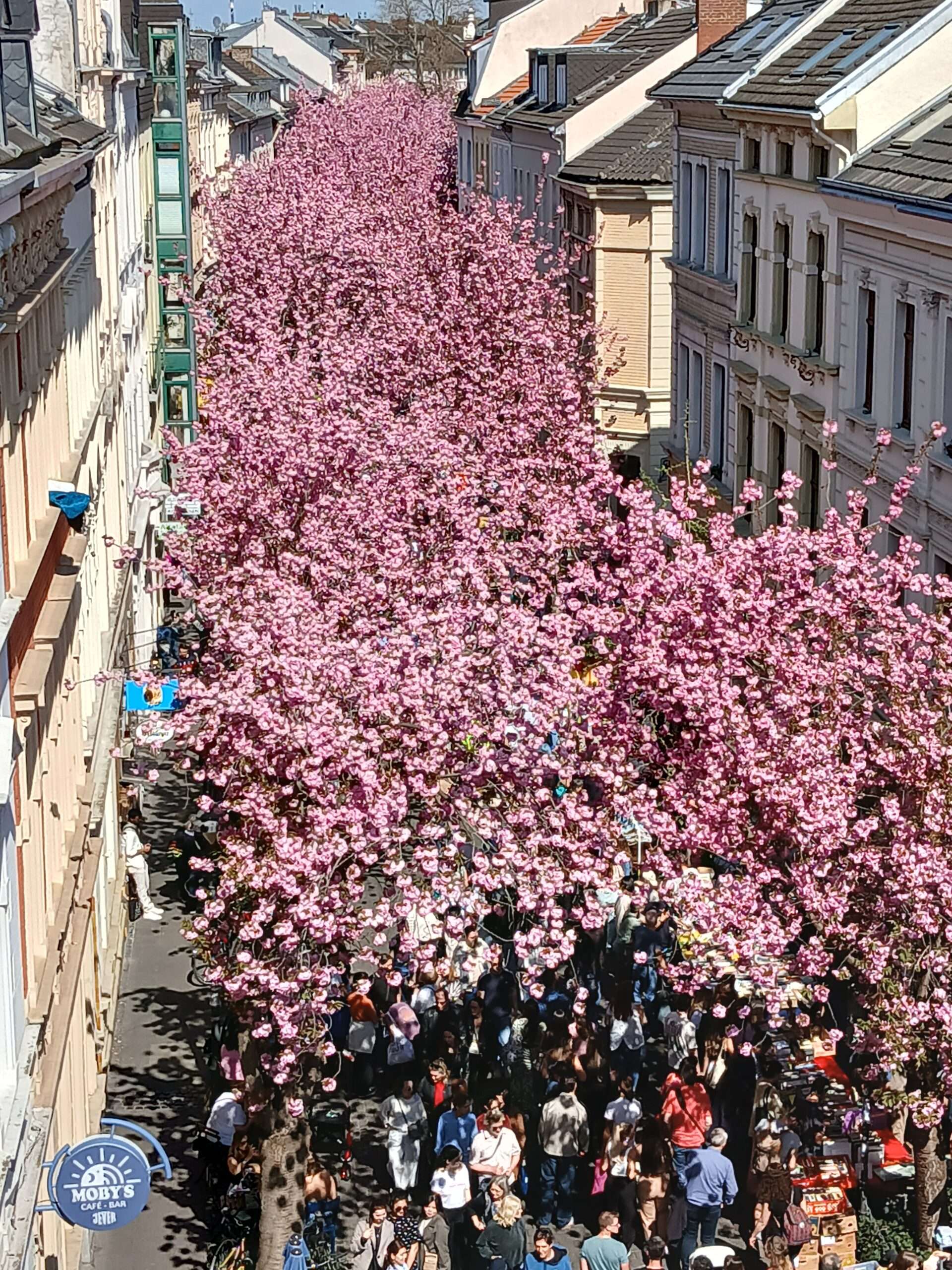

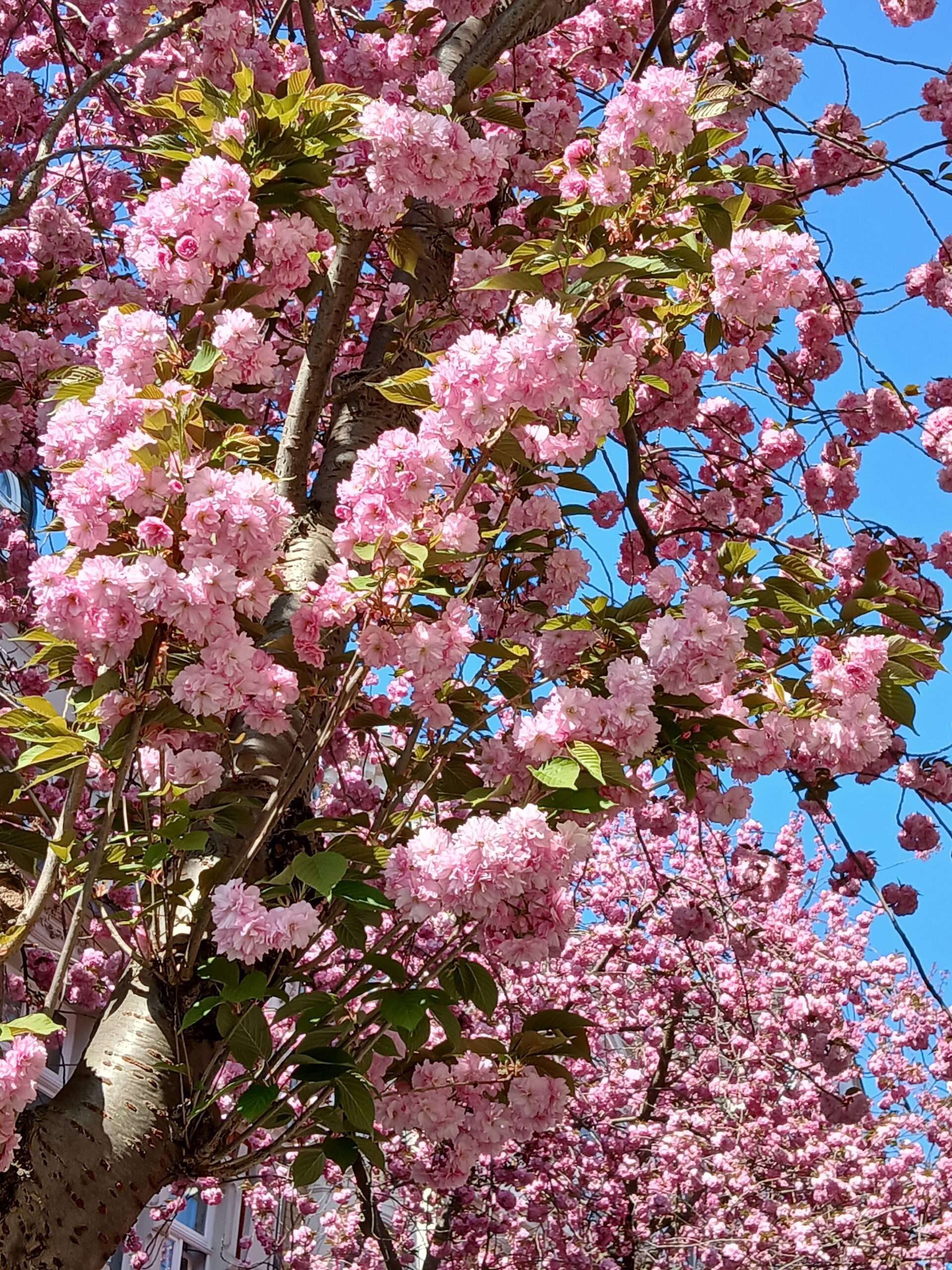
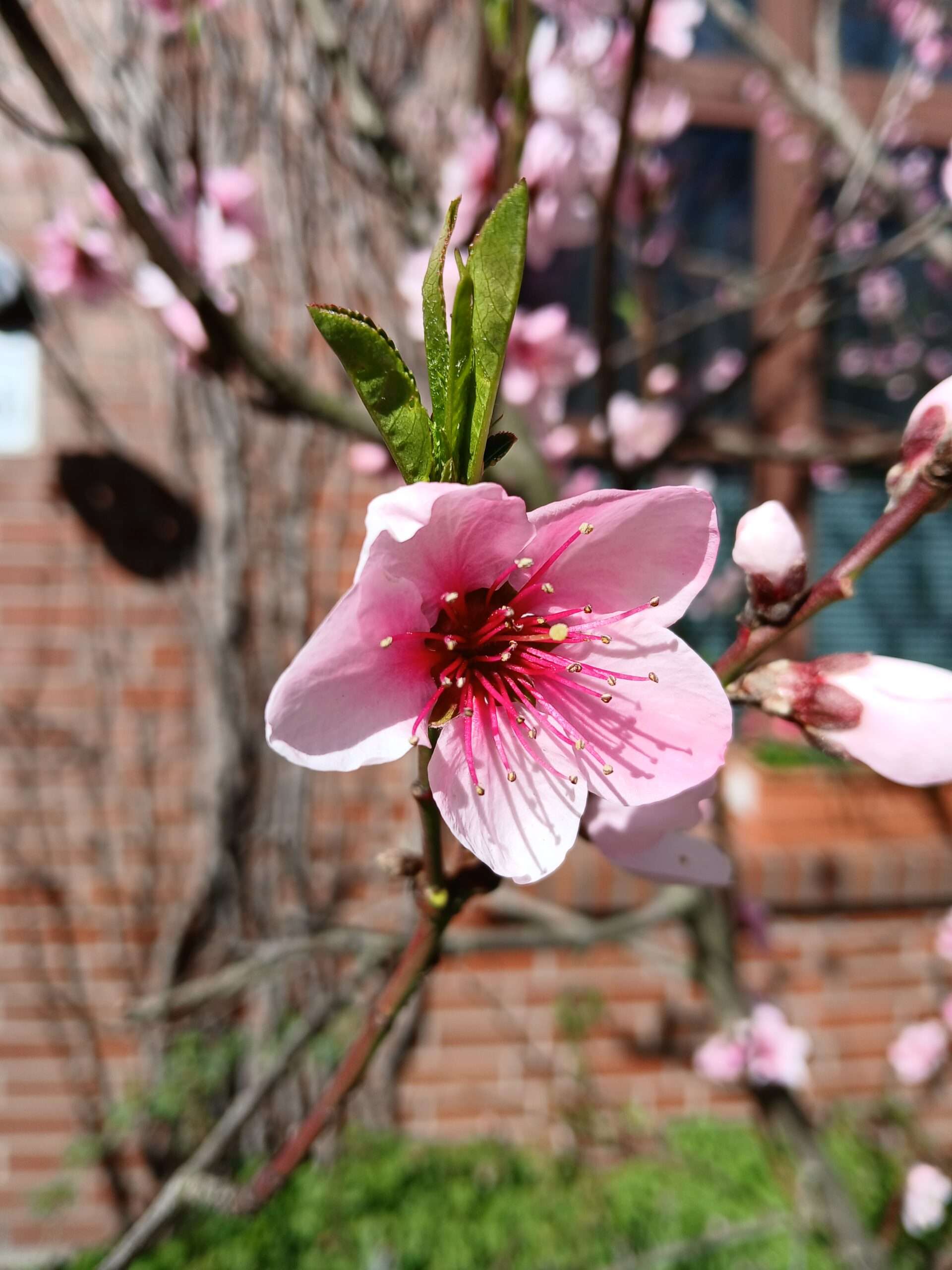

 From the terrace of the castle, you can see as far as Cologne Cathedral and, of course, the whole of Bonn. The view, under a bright blue sky, is truly magical. Fortunately in the 1970s a citizens’ initiative was able to save the castle from demolition with a view to construct a motorway junction.
From the terrace of the castle, you can see as far as Cologne Cathedral and, of course, the whole of Bonn. The view, under a bright blue sky, is truly magical. Fortunately in the 1970s a citizens’ initiative was able to save the castle from demolition with a view to construct a motorway junction.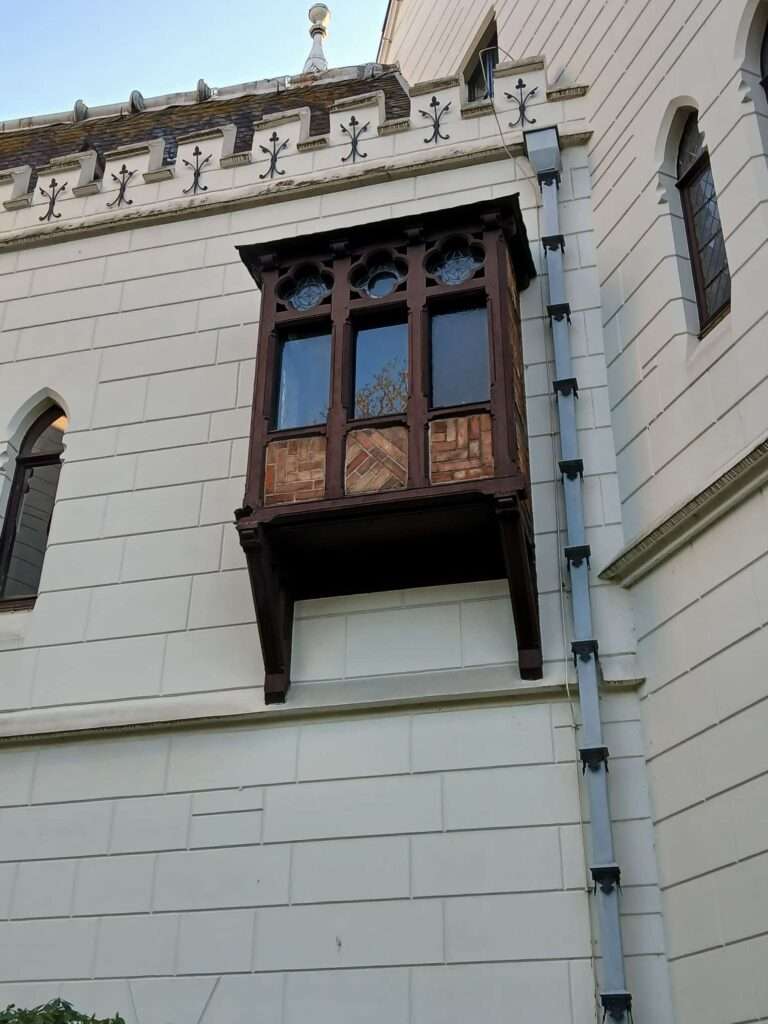
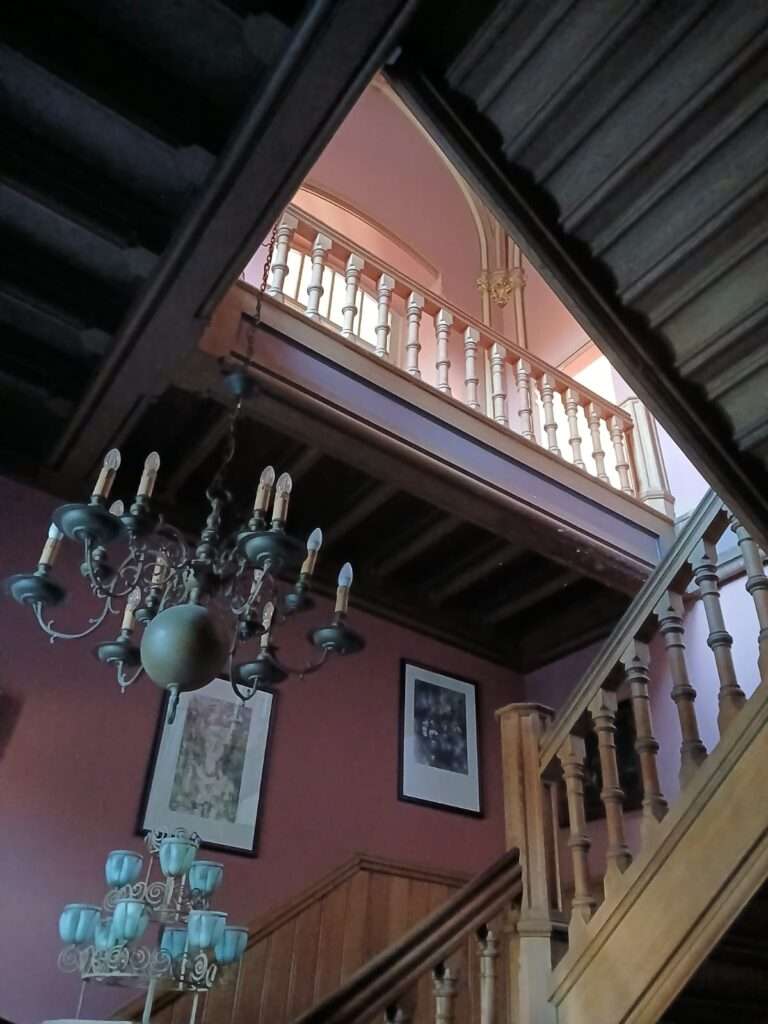

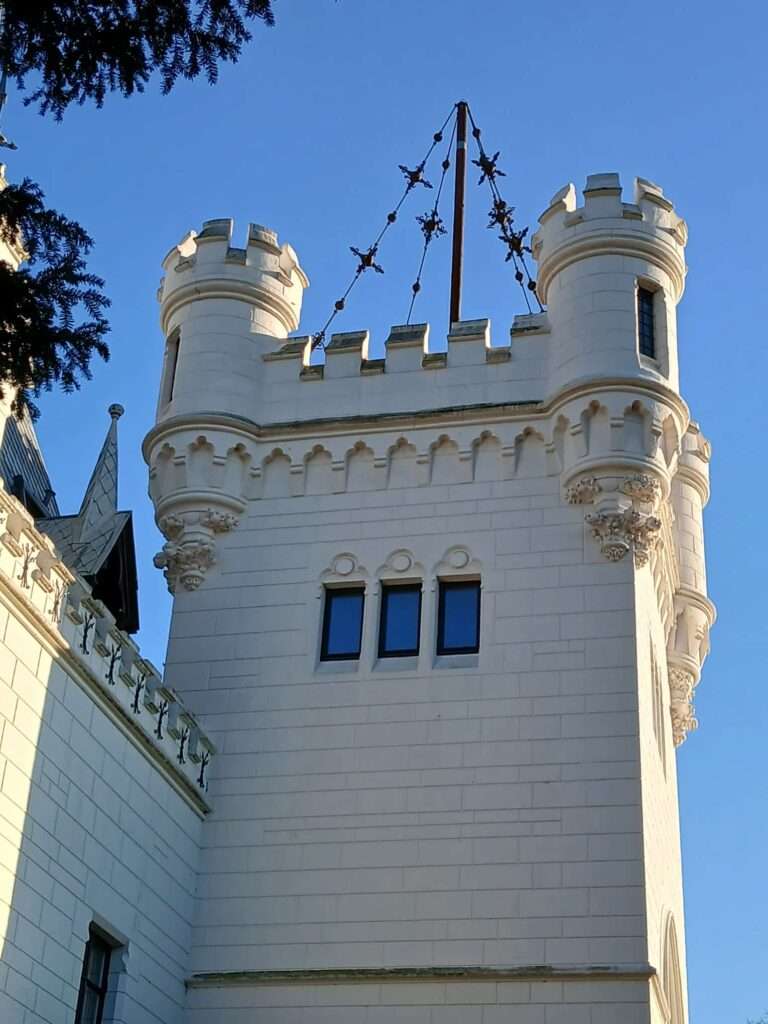


Recent Comments